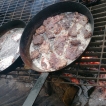TRADITIONAL Food
Traditional Food Sampling for a total diet study (TDS) suite of contaminants
Traditional food composites will be collected on the basis of dietary questionnaires, so that collected foods represent at least 80% of the traditional foods consumed that season/year in each of the communities. The list of traditional food composites will be developed for each region and may be updated to take into consideration changing geography (dietary areas/ecozones) of the survey and latest intake information.
A tentative food-sampling strategy is as follows:
- Up to 30 food samples will be collected from each participating community.
- The community will identify the most commonly consumed food, the foods that are of the most concern and foods that are known to accumulate higher concentrations of contaminants.
- Each of the food samples will be a composite of tissues from 5 different animals or plants.
The traditional food samples collected will be analyzed for the following categories of toxic chemicals, based on the general structure of the Canadian Total Diet Study 1992-1999. pesticide residues polychlorinated biphenyls (PCBs) polychlorinated dibenzo-p-dioxins and polychlorinated dobenzofurans Trace metals Polycyclic Aromatic Hydrocarbons (PAHs) Polybrominated fire retardants (PBDEs) Perflourinated Compounds (PFOS/PFOA) Pharmaceuticals and Personal Care Products (PPCPs)
In addition, traditional food composites will be analyzed for essential nutrients and vitamins.






